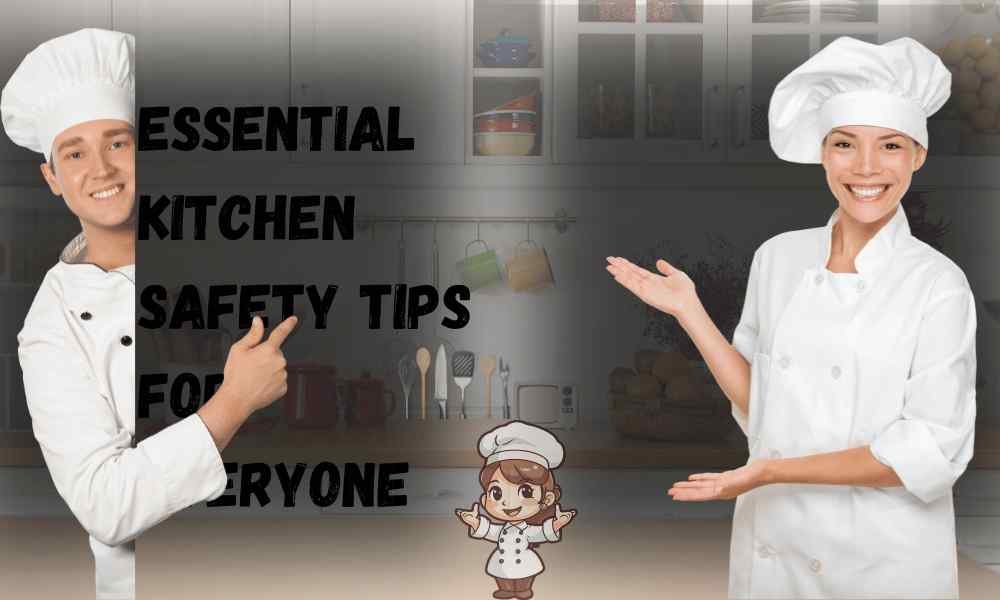Keeping your kitchen secure is critical for a satisfied and stable cooking experience! The kitchen acts as the central hub for food prep, so maintaining safe surroundings to save you injuries and injuries is paramount. Here are some Essential Kitchen Safety Tips for Everyone.
Firstly, practicing desirable hygiene is key. Wash your fingers thoroughly before coping with any food to save you from from the unfolding of microorganisms. Additionally, separate reducing forums for uncooked meat and produce is every other Kitchen Safety Tip for Everyone. This simple step allows keep away from cross-contamination, which may lead to foodborne infection.
Equipping the kitchen with protection necessities like a hearth extinguisher and often checking expiration dates on perishable items further enhances protection protocols. By adhering to those practices, people can create more secure cooking surroundings for themselves and their loved ones.
15 Kitchen Safety Rules in the Kitchen:
Wash hands before handling food:
Before starting any food practice, it’s far vital to thoroughly wash your fingers with soap and water. This easy step helps take away dirt, bacteria, and other contaminants from your palms, lowering the threat of shifting harmful pathogens to the food you are getting ready.
Use separate cutting boards for raw meat and produce:
Cross-infection is a huge situation inside the kitchen, especially when handling uncooked meat and sparkling produce. Using separate reducing forums—one for uncooked meat and another for results and vegetables—facilitates saving microorganisms from uncooked meat from contaminating ready-to-eat foods, lowering the risk of foodborne illnesses.
Keep pot handles turned inward on the stove:
When cooking at the range, make certain pot handles are turning inward, away from the stove’s side. This simple precaution facilitates preventing unintended spills or tipping, reducing the risk of burns or accidents resulting from warm food or drinks.
Avoid wearing loose clothing while cooking:
Loose apparel, which includes saggy sleeves or dangling earrings, can pose safety dangers inside the kitchen. They may additionally trap the fireplace, get stuck in the device, or come into touch with hot surfaces. To decrease the chance of injuries, it’s best to put on appropriate garb and secure free objects earlier than cooking.
Use oven mitts or potholders to handle hot cookware:
Flammable items such as dish towels, paper towels, and cooking oil have to be stored close to the stove to prevent unintended fires. These merchandise can easily catch fireplaces if they come into touch with flames or warm surfaces, so storing them in a secure area within the cooking vicinity is important Again, be cautious during the usage of cooking oil, because it gets too warm, it without difficulty splashes and burns.
Keep flammable objects away from the stove:
Flammable items such as dish towels, paper towels, and cooking oil should be stored near the stove to prevent accidental fires. These products can easily catch fire if they come into contact with flames or hot surfaces, so storing them in a safe place within the cooking area is important Again, be careful when using cooking oil, because when it gets too hot, it easily splashes and burns.
Use a kitchen timer to prevent overcooking:
Using a kitchen timer is a reliable manner to ensure your food is cooked flawlessly without overcooking. By placing a timer, you could accurately control the cooking time, preventing pots from scorching or overheating, which could compromise the flavor and texture of your dish.
Keep knives and sharp utensils out of reach of children:
Sharp knives and forks are essential tools in the kitchen but can pose a serious safety risk, especially for children. To prevent accidents and injuries, keep knives and other sharp objects in a safe place, such as a locked drawer or high cabinet, out of the reach of children safely.
Clean up spills immediately to prevent slips and falls:
Spills and messes in the kitchen can create slippery surfaces, raising the danger of slips and falls. To hold a secure cooking environment, it’s important to smooth up spills directly with the usage of a smooth cloth or paper towel. This saves you from accidents and guarantees that the kitchen stays in a secure and threat-free area.
Use caution when opening hot oven doors and lids:
When cooking in the oven or using pots with hot lids, exercise caution while establishing them to keep away from burns or steam-related accidents. Always use oven mitts or potholders to shield your palms from the heat, and open oven doorways and lids slowly to launch steam accurately. Taking these precautions reduces the risk of burns and guarantees safe dealing with warm cookware.
Never leave cooking food unattended on the stove:
It’s vital by no means to leave meals unattended while cooking on the range. Unattended cooking poses a hearth chance and will increase the hazard of accidents such as spills or boil-overs. Always live in the kitchen whilst cooking and attend to the stove to save you from mishaps and make certain that food is cooked accurately and nicely.
Keep a fire extinguisher accessible in the kitchen:
A fire extinguisher is an important protection tool for managing kitchen hearth emergencies. Ensure a fashionable fireplace extinguisher is on the market and is especially ideal for kitchen fires. Place it far away from the stove but inside easy to attain, and ensure everybody in the household is aware of its region and right usage. Having a fire extinguisher on hand can assist include small fires quickly, minimizing asset harm and decreasing the chance of accidents before the state of affairs escalates.
Use microwave-safe containers for reheating food:
When reheating meals inside the microwave, it’s critical to use packing containers which can be categorized microwave-secure. These containers are designed to undergo the heat produced via the microwave without melting, warping, or freeing harmful chemicals into your meals. Using a non-microwave-safe box can be a protection threat, doubtlessly leading to meal contamination or adverse the container.
Check expiration dates on perishable items regularly:
Keeping your kitchen safe is more than just preventing burns and cuts! Tips everyone needs on kitchen safety also include how to handle food properly and avoid foodborne illnesses. Perishable products such as dairy, meat, and produce have an expiration date which is a guide to how fresh and safe they are to eat. Here is another important kitchen safety tip: Check the expiration dates of these items regularly. Discard anything that is above outstanding or shows signs of contamination, such as an unusual odor, discoloration, or discoloration. Remember, when in doubt, drop it! This helps prevent the growth of harmful bacteria that can make you sick. Important Restaurant Safety Tips for Everyone Keep your refrigerator at a comfortable temperature, usually around 40°F (4°C). This.
Store raw meat and poultry on the bottom shelf of the refrigerator:
Raw meat and hens can contain harmful microorganisms that may contaminate other foods if no longer stored properly. To prevent go-infection and reduce the hazard of foodborne contamination, it is recommended to keep raw meat and roosters on the lowest shelf of the refrigerator. This helps save your juices from dripping onto different foods and decreases the likelihood of bacteria spreading to ready-to-eat objects saved on higher cabinets. Additionally, keep in mind setting raw meat and fowl in sealed packing containers or on trays to similarly incorporate any potential drips or spills.
Some Additional Tips:
Proper food storage:
Provide steerage on storing leftovers and perishable gadgets efficaciously to hold freshness and prevent food spoilage. Include guidelines on the usage of airtight packing containers, labeling meals with dates, and organizing the refrigerator to optimize the garage area and limit waste.
Safe handling of kitchen appliances:
Offer pointers on accurately using kitchen appliances including blenders, food processors, and toaster ovens. Include instructions for proper cleaning, maintenance, and storage of home equipment to prolong their lifespan and ensure safe operation.
Fire safety precautions:
Expand on hearth safety hints using discussing common causes of kitchen fires and the way to save them. Offer advice on preserving flammable gadgets away from heat resources, the use of warning when cooking with oils, and having an evacuation plan in case of a fireplace emergency.
First aid essentials:
Highlight the significance of getting a nicely stocked first aid package in the kitchen and offer a listing of important objects to include, inclusive of bandages, antiseptic wipes, and burn ointment. Offer guidance on administering easy first useful resource for common kitchen injuries, consisting of cuts, burns, and minor burns.
Kitchen organization and efficiency:
Share tips for organizing the kitchen layout to improve performance and safety. Offer recommendations on decluttering countertops, maximizing garage area, and creating designated zones for exceptional responsibilities, along with meal prep, cooking, and cleansing.
Conclusion:
Prioritizing kitchen protection is vital for creating a steady and exciting cooking environment. By following the hints and guidelines mentioned in this newsletter, you may lessen the threat of accidents, injuries, and foodborne ailments even by maximizing performance and leisure within the kitchen. Remember to exercise the right hygiene, deal with food and devices with care, and stay vigilant always. With a focal point on safety and mindfulness, you could with a piece of success navigate the kitchen and create delicious food for yourself and your family. Here’s to satisfied and safe cooking!
FAQs (Frequently Asked Questions) about Kitchen Safety:
Why is kitchen safety important?
Kitchen protection is vital as it prevents accidents, injuries, and foodborne illnesses. By following safety suggestions, you could create a stable environment for cooking and limit risks associated with dealing with meals and kitchen gadgets.
How can I prevent burns in the kitchen?
To save you burns, continually use oven mitts or potholders when managing warm cookware, and exercise warning while starting warm oven doorways and lids. Additionally, hold flammable objects far from the range and keep away from carrying free clothing whilst cooking.
What should I do in case of a kitchen fire?
In the case of a kitchen fireplace, do not forget to prioritize protection first. If the fireplace is small and practicable, you could attempt to extinguish it with the use of a fire extinguisher. However, if the heart is large or spreading quickly evacuate the location without delay and phone emergency services.
How can I prevent cross-contamination in the kitchen?
To prevent move-contamination, use separate slicing boards for uncooked meat and bring, and wash your arms very well after coping with uncooked meat. Additionally, smooth countertops, utensils, and surfaces frequently to eliminate mmicroorganismsand prevent the spread of risky pathogens.
What are some common kitchen safety hazards to be aware of?
Common kitchen protection dangers include slips and falls because of spills or moist flooring, burns from heat surfaces or beverages, cuts from sharp knives and utensils, and fires from overheated cooking oil or unattended cooking. By identifying those risks and taking preventive measures, you can decrease dangers and sell safe cooking surroundings.



